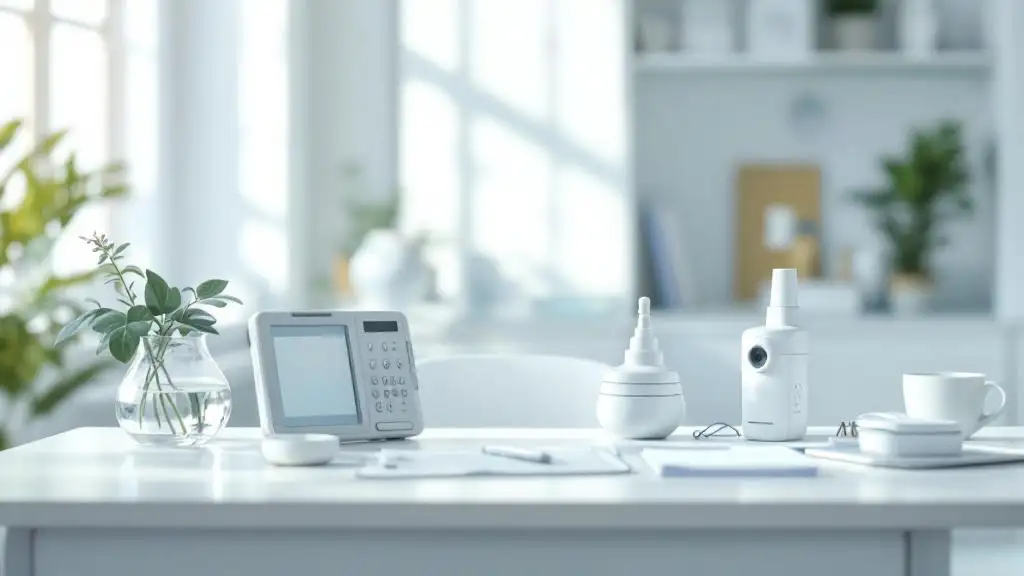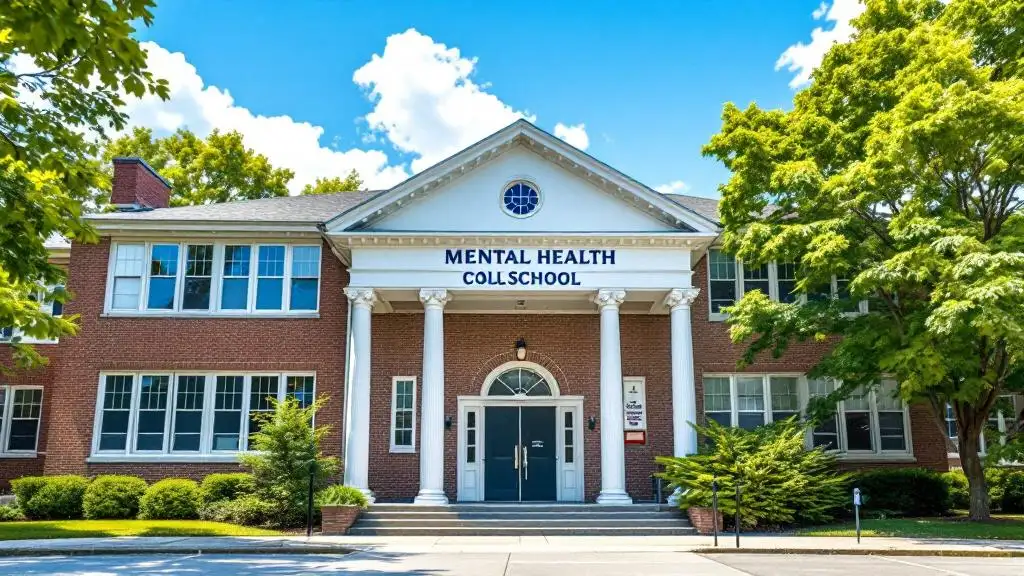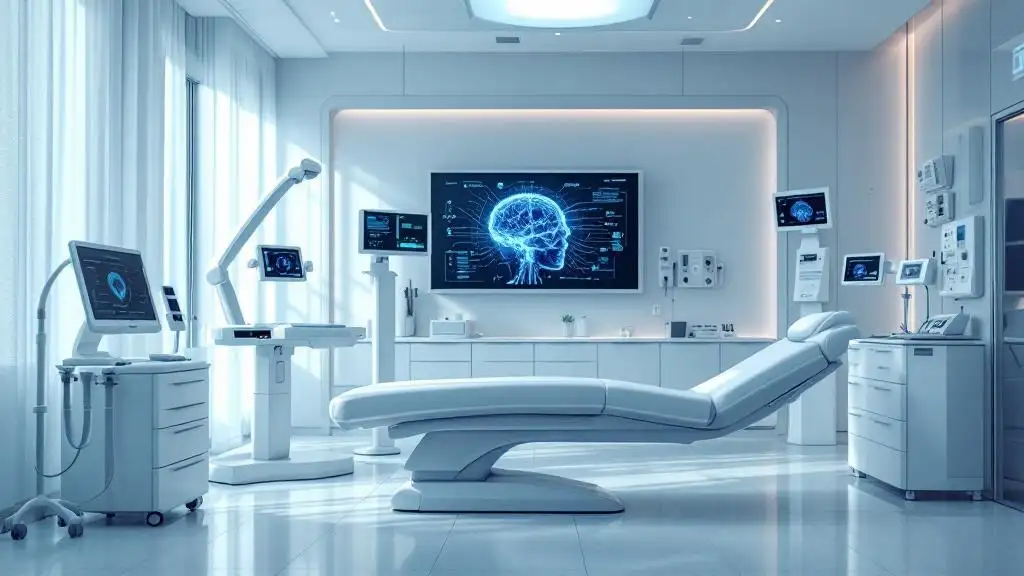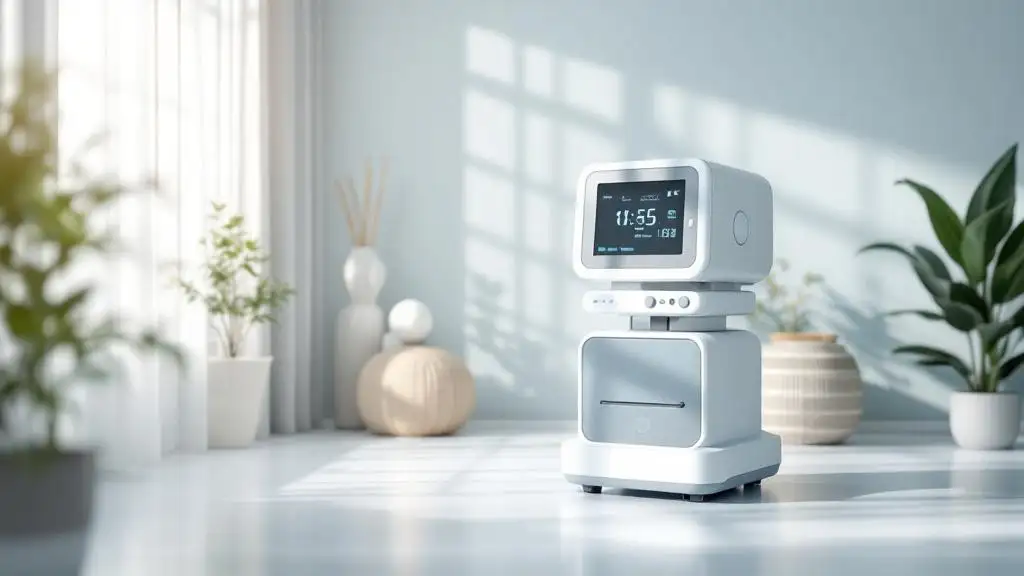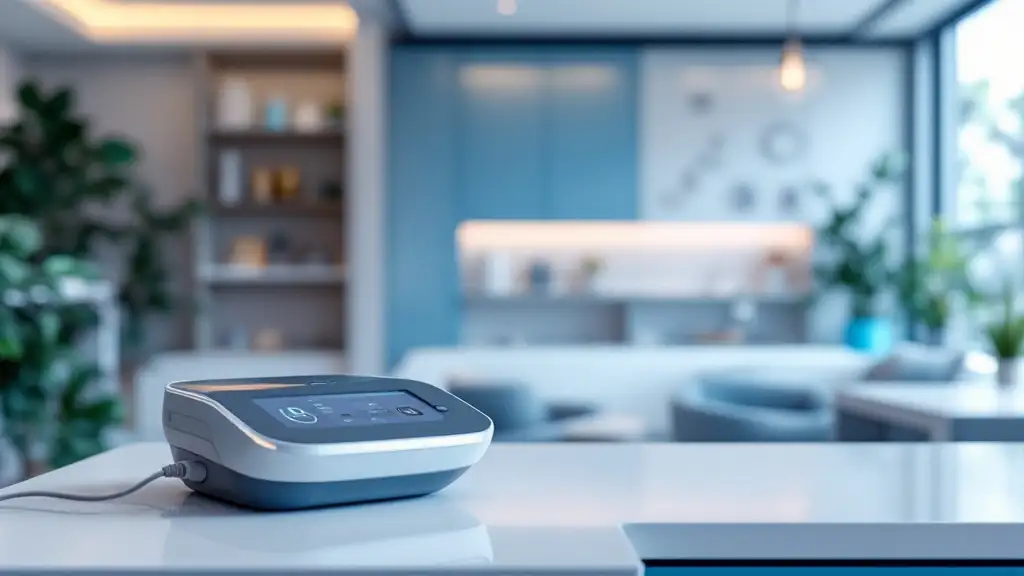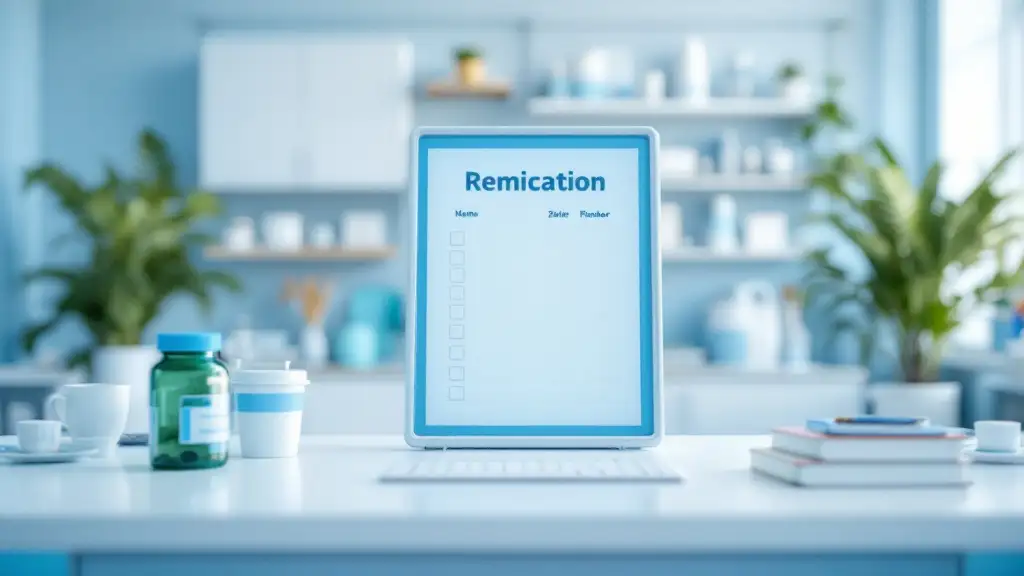Understanding Telepsychiatry and Its Role in Mental Health
Telepsychiatry, a subset of telehealth, involves delivering psychiatric assessment and treatment via video, phone, or online platforms. Over the past decade, especially accelerated by the COVID-19 pandemic, it has emerged as a pivotal tool in making mental health services more accessible. This mode of care leverages modern electronic communication technologies to reach individuals in remote, underserved, or stigmatized communities, facilitating continued management of depression and other mental health conditions.
Effectiveness of Telepsychiatry in Treating Depression
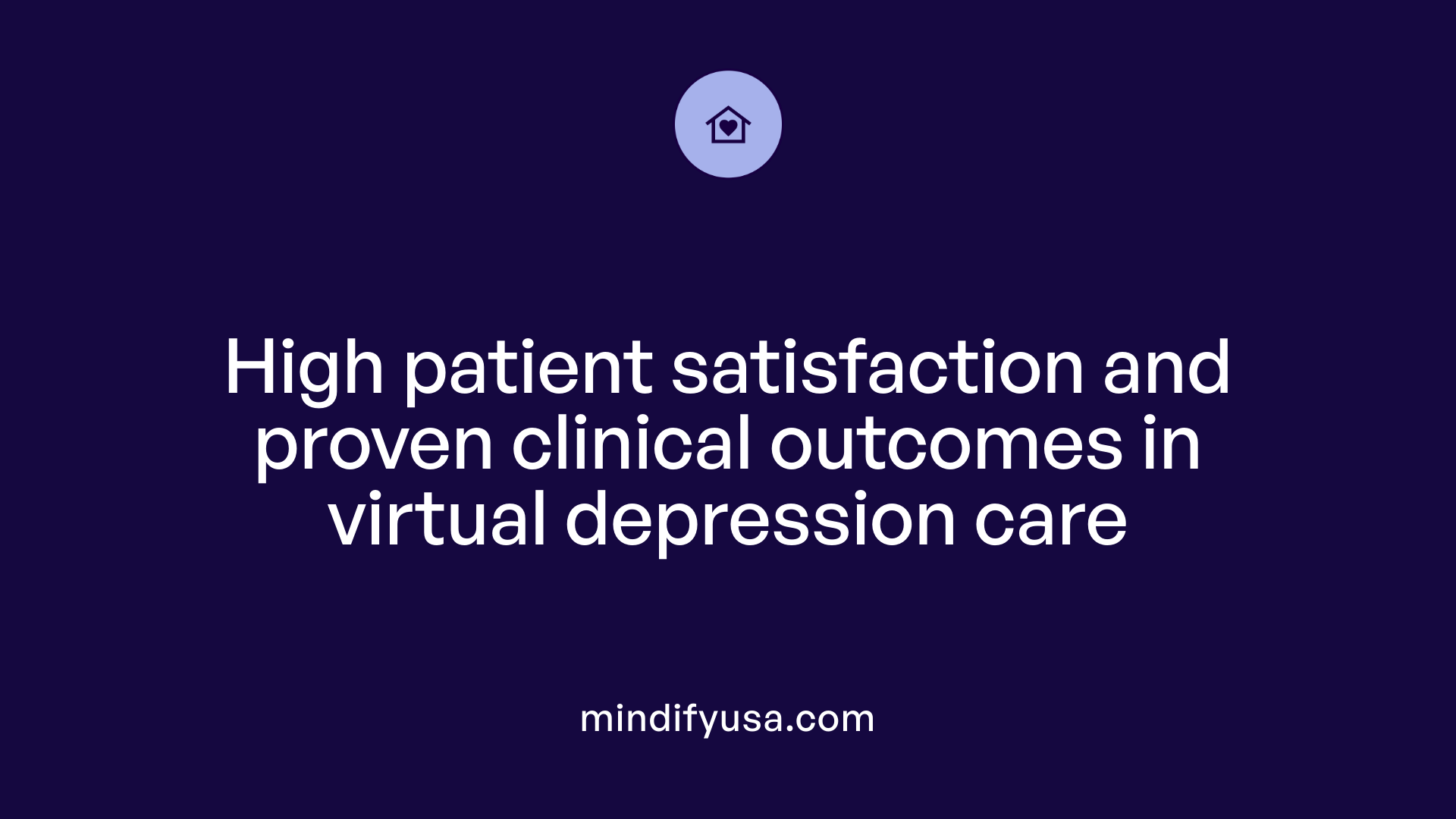
What does scientific research say about the effectiveness of telepsychiatry for depression?
Numerous studies over the past decade have consistently shown that telepsychiatry is on par with traditional in-person treatment regarding accuracy, outcomes, and patient satisfaction. Research indicates that diagnostic reliability remains high when care is delivered virtually, and treatment outcomes, including symptom reduction and remission rates, are comparable to face-to-face care.
A systematic review encompassing 17 randomized controlled trials with over 1,800 participants demonstrated no significant difference in treatment effectiveness between telepsychiatry and in-person therapy. Patient satisfaction levels are generally high across age groups, with many studies reporting satisfaction ratings equal to or exceeding those of traditional care.
Organizations like the American Psychiatric Association endorse telepsychiatry, highlighting its safety, ethical implementation, and capacity to integrate seamlessly into psychiatric practice. It is especially valuable in expanding access to underserved communities and overcoming barriers such as transportation, stigma, and healthcare shortages.
Research from Canada and the United States further confirms that telepsychiatry provides high-quality care, including in rural areas where healthcare resources are limited. During the COVID-19 pandemic, an increase in telehealth utilization underscored its role in continuity of care for depression and other mental health conditions.
How effective is telepsychiatry in treating depression?
Telepsychiatry has demonstrated effectiveness equal to in-person psychiatric care for depression. Studies have shown that virtual services, including videoconferencing, phone-based therapy, and hybrid models, yield similar improvements in depressive symptoms, treatment adherence, and overall functioning.
In one large-scale study involving more than 6,200 patients, most received treatment within four days of enrollment, with symptom improvements of 90% achieving meaningful clinical change. The average time to remission was approximately one month, with high patient satisfaction scores averaging 4.6 out of 5.
Furthermore, evidence suggests that telepsychiatry can effectively monitor depression over time, using automated symptom tracking and care coordination tools. Its capacity to facilitate evidence-based therapies such as cognitive-behavioral therapy (CBT) and medication management contributes to its success.
This modality is particularly beneficial for individuals in remote or underserved areas, where traditional mental health services are scarce. It helps to mitigate barriers like transportation difficulties and social stigma, thereby increasing treatment engagement and adherence.
Clinical Outcomes Comparison
| Study Type | Population | Main Findings | Significance |
|---|---|---|---|
| Meta-analyses | Various | No significant difference in treatment efficacy between telepsychiatry and in-person care | Supports equivalence in outcomes |
| Randomized Controlled Trials | Patients with depression and anxiety | Symptom reduction and remission comparable across modalities | Confirms virtual therapy efficacy |
| Program Evaluations | Rural and underserved populations | High satisfaction and successful symptom management | Demonstrates accessibility and effectiveness |
| Cost-Effectiveness Studies | General population | Reduced costs and increased efficiency with telepsychiatry | Cost savings without compromising quality |
Symptom Reduction and Treatment Adherence
Studies indicate that telepsychiatry effectively reduces depression severity and other mood symptoms. Patients report significant improvement after a series of virtual sessions, with symptom scores showing statistically and clinically meaningful reductions.
Treatment adherence tends to be higher or comparable in telepsychiatry compared to traditional face-to-face therapy. Convenience factors, such as reduced travel and flexible scheduling, contribute to sustained engagement.
The ability to monitor symptoms remotely and adjust treatments promptly ensures continuity of care, leading to better outcomes. Automated symptom tracking and regular follow-ups aid in maintaining high adherence levels.
Patient Satisfaction
Research consistently shows that patients are highly satisfied with virtual mental health services. Satisfaction ratings often surpass those of in-person care, especially when convenience and accessibility are considered.
For instance, in a study involving elderly veterans, no difference in satisfaction or symptom relief was found between telemedicine and in-person groups. Patients appreciate the comfort, privacy, and reduced logistical challenges that telepsychiatry offers.
In summary, strong evidence supports the use of telepsychiatry as a reliable and effective alternative to in-person treatment for depression. It enhances access, maintains high treatment quality, and results in significant symptom improvement, making it a valuable component of modern mental health care.
Patient Satisfaction and Clinical Outcomes
What does scientific research say about the effectiveness of telepsychiatry for depression?
Scientific studies over the past decade, primarily conducted in the United States, strongly support the effectiveness of telepsychiatry in managing depression. A substantial body of evidence shows that virtual psychiatric care can match or even surpass in-person treatment outcomes.
Research indicates that telepsychiatry provides comparable diagnostic accuracy, symptom improvement, and treatment response rates. For instance, a comprehensive review found no significant differences in depression severity reduction between telehealth and face-to-face treatments. Several controlled trials with hundreds of participants demonstrated significant symptom relief, remission, and high patient retention rates in telepsychiatry settings.
One notable study analyzed 1,826 patients across the U.S., finding that about 62% of patients with depression experienced remission and significant symptom reduction after an average of five appointments over 15 weeks. Outcomes in rural areas were comparable to urban settings, highlighting its potential to reduce health disparities. These findings are consistent with systematic reviews by organizations such as the American Psychiatric Association and the Journal of Medical Internet Research, which endorse telepsychiatry’s safety, ethical standards, and integration into routine practice.
Overall, evidence underscores telepsychiatry as a reliable, effective option for depression treatment, especially important during circumstances like the COVID-19 pandemic when access to in-person care is limited.
Patient satisfaction with telepsychiatry
Patients generally report high satisfaction with telepsychiatry services. Multiple studies across diverse populations indicate that individuals appreciate the convenience, flexibility, and reduced travel burden associated with virtual care. A recent large-scale study involving over 6,200 patients found that 90% experienced symptom improvement, and patient reviews averaged 4.6 stars out of 5, highlighting a positive treatment experience.
Furthermore, patient perceptions of the therapeutic alliance—an essential component of successful mental health treatment—remain strong in virtual environments. Research shows that the quality of virtual interactions does not diminish the clinician-patient relationship. Patients often feel heard and connected, even without face-to-face contact.
High satisfaction rates extend across age groups and socioeconomic backgrounds. For example, older adults, low-income populations, and rural residents report that telepsychiatry improves access and engagement, leading to better adherence and outcomes.
Comparison of outcomes between telepsychiatry and in-person treatment
Robust research indicates that telepsychiatry is as effective as traditional in-person care for depression. Numerous controlled trials and meta-analyses reveal no significant difference in symptom reduction, remission, or quality of life outcomes.
In a large randomized trial comparing telehealth and in-person care, patients in both groups showed similar improvements in depression scores, general well-being, and functioning. Interestingly, some studies observe that the treatment duration and likelihood of completing therapy are slightly higher in telehealth settings, possibly due to increased convenience.
Furthermore, the therapeutic alliance—the collaborative bond between provider and patient—is maintained at comparable levels across both modalities. This supports the premise that virtual interactions can foster meaningful, trust-based relationships.
Overall, this broad scientific consensus affirms telepsychiatry as a well-supported alternative for depression management, offering the same benefits as face-to-face therapy while increasing accessibility for underserved and remote populations.
| Aspect | Findings | Additional Notes |
|---|---|---|
| Effectiveness | Similar reduction in depression severity | No significant difference in response rates |
| Patient satisfaction | High and often exceeding in-person care | Increases with convenience and therapeutic alliance |
| Treatment retention | Slightly higher in telepsychiatry | Facilitated by flexible scheduling |
| Applicability | Effective across age, race, and geographic groups | Especially beneficial for rural and underserved populations |
These findings collectively support the integration of telepsychiatry into standard depression treatment protocols, emphasizing its role in expanding access, maintaining quality, and improving patient outcomes.
Cost-Effectiveness and Accessibility
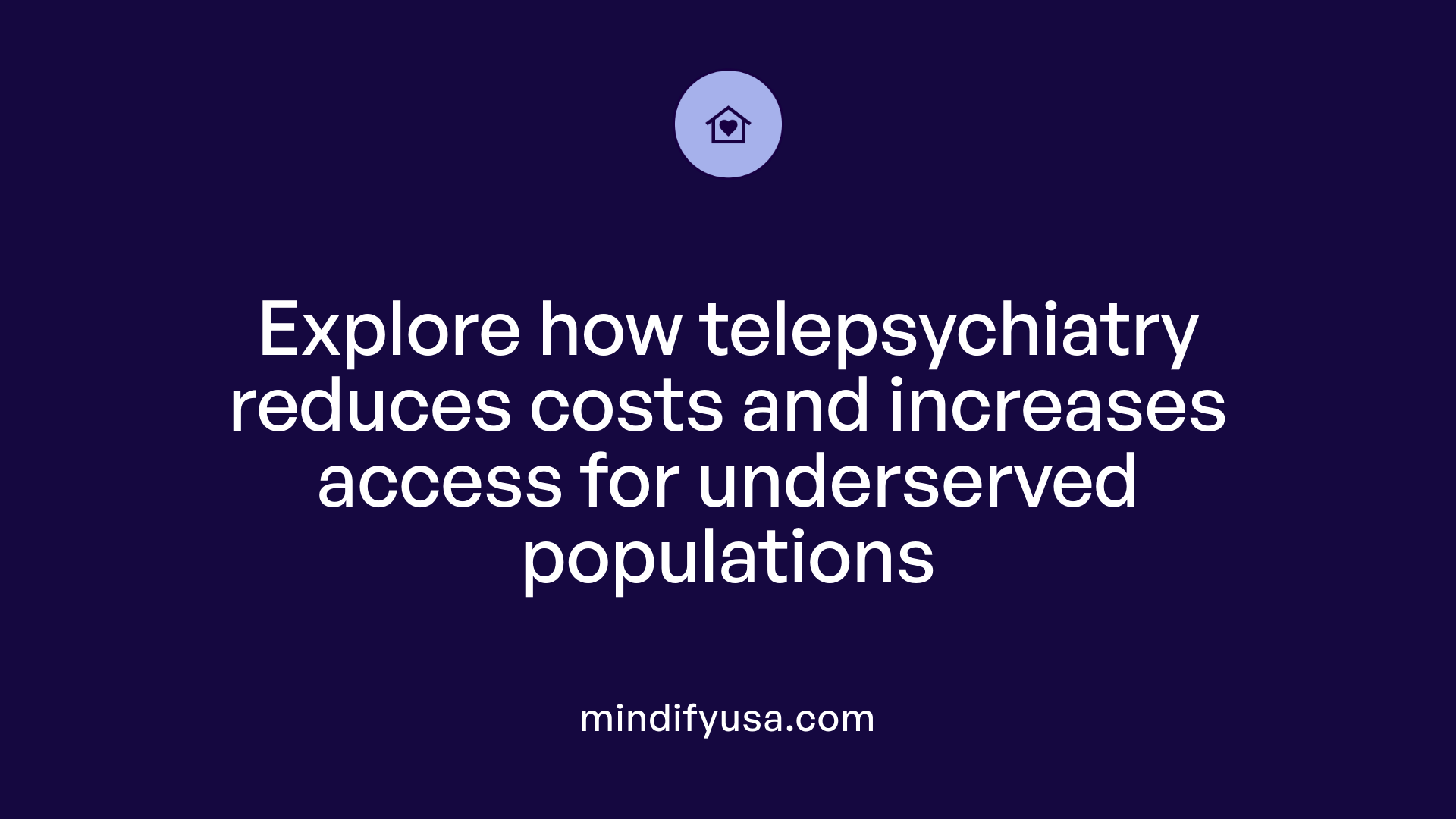 Telepsychiatry not only offers clinical benefits but also presents significant economic advantages that can expand access to mental health care, especially for underserved populations.
Telepsychiatry not only offers clinical benefits but also presents significant economic advantages that can expand access to mental health care, especially for underserved populations.
One of the primary benefits of telehealth is its potential for cost savings. Virtual care reduces expenses related to transportation, such as travel costs and time off work. Patients in rural or remote areas can avoid long journeys to healthcare facilities, making regular treatment more feasible and improving adherence.
Moreover, telepsychiatry can lead to increased availability of services. It helps mitigate barriers like provider shortages and scheduling conflicts, especially in underserved communities. Consequently, it enhances access for groups that traditionally face difficulties, such as those with limited mobility, transportation issues, or stigma concerns.
Initial investment in technology infrastructure may be higher, but studies show that telepsychiatry often results in long-term savings for healthcare systems. For example, it reduces unnecessary hospitalizations and emergency visits by providing timely interventions.
Research highlights that telehealth effectively reaches vulnerable populations, including low-income groups. For instance, telephone-based interventions, which are easier to access for individuals without reliable internet, have proven effective in managing depression among low-income populations.
Statistics reveal a higher rate of telehealth usage among populations with significant mental health needs. People with more frequent healthcare visits and multiple health conditions are more inclined to utilize telepsychiatry services, suggesting its role in managing complex cases.
Below is a summary of the benefits of telepsychiatry in terms of cost and accessibility:
| Aspect | Benefits | Additional Notes |
|---|---|---|
| Economic savings | Reduced transportation costs, lower overall treatment expenses | Long-term cost-effectiveness due to fewer hospitalizations |
| Increased accessibility | Reaches underserved, rural, and low-income populations | Especially effective via telephone interventions |
| Convenience | Reduced wait times, flexible scheduling | Enhances treatment adherence and engagement |
| Patient satisfaction | High satisfaction ratings across age groups | Patients appreciate easy access and privacy |
| Technology barriers | Limited internet access and digital literacy pose challenges | Telephone-based therapy remains a practical alternative |
In summary, telehealth makes mental health services more affordable and reachable for diverse patient groups. Its ability to reduce costs while overcoming geographical and social barriers positions telepsychiatry as a highly effective tool in modern depression care. Evidence from numerous studies supports its role in expanding access and improving outcomes across a broad spectrum of populations.
Addressing Barriers and Inequities through Telepsychiatry

What is telehealth and how does it impact mental health care?
Telehealth refers to the use of electronic communication technologies, such as video calls, online messaging, and remote patient monitoring, to deliver healthcare services from a distance. In mental health care, telehealth significantly enhances access by enabling individuals to receive therapy and psychiatric support without needing to visit healthcare facilities.
This approach is especially beneficial for underserved communities and those in remote locations, where traditional in-person services are limited. Telehealth allows for quicker, more flexible scheduling and ongoing management of mental health conditions, reducing barriers like travel time, wait times, and geographical constraints.
The COVID-19 pandemic accelerated the adoption of telehealth, demonstrating its vital role in maintaining continuity of mental health services while minimizing infection risks. Overall, telehealth improves the accessibility, convenience, and consistency of mental health support, although it may not fully replace in-person care in all circumstances.
What are the disadvantages of telepsychiatry?
Despite its advantages, telepsychiatry faces several challenges. Technical issues, such as unstable internet connections and hardware problems, can disrupt sessions and impact care quality.
Limited virtual assessments may hinder physical examinations and the interpretation of non-verbal cues, possibly affecting diagnostic accuracy and the strength of the therapeutic relationship.
Privacy concerns are also significant. Risks of cybersecurity breaches and privacy breaches in shared home environments can compromise patient confidentiality.
Furthermore, telepsychiatry may not be suitable for emergency or severe crisis situations requiring immediate, in-person intervention. Legal restrictions can limit remote prescribing of certain medications, especially controlled substances.
Ongoing technological improvements and regulatory updates are striving to mitigate these disadvantages, aiming for a balanced approach that maximizes benefits while minimizing risks.
Is telehealth as effective as in-person mental health treatment?
Current scientific evidence supports that telehealth provides treatment outcomes comparable to in-person mental healthcare. Numerous studies have shown no significant difference in symptom reduction, patient satisfaction, or overall quality of life between the two modalities.
For example, research comparing groups receiving either in-person or remote care found similar improvements in depression and anxiety symptoms, with some data even indicating slightly better outcomes with telehealth in certain cases.
Treatment duration and adherence are often comparable or even higher in telehealth settings, alongside high patient and provider satisfaction levels.
While certain logistical aspects, like longer treatment times, have been noted, the overall body of evidence confirms telehealth as an effective, safe, and convenient alternative to traditional face-to-face care.
What does scientific research say about the effectiveness of telepsychiatry for depression?
Extensive research underscores telepsychiatry’s effectiveness in treating depression. Multiple high-quality studies have shown it can deliver diagnostic accuracy and therapeutic outcomes equal to in-person treatment.
Research findings demonstrate that telepsychiatry reduces depression severity, improves response rates, and enhances remission probabilities. Patients report high satisfaction levels, valuing the convenience and reduced stigma associated with remote care.
The American Psychiatric Association and other organizations endorse telepsychiatry’s safety and ethical standards. This modality notably increases access for underserved and rural populations, often resulting in better treatment adherence and engagement.
These findings affirm that telepsychiatry is not only an alternative but a reliable option for depression management, with a substantial evidence base supporting its use.
How effective is telepsychiatry in treating depression?
Research consistently illustrates that telepsychiatry is as effective as in-person care for depression treatment. It employs various communication methods, including videoconferencing and phone calls, to provide comprehensive services like assessments, therapy, medication management, and education.
Studies have shown that patients receiving treatment via telepsychiatry experience similar improvements in depression symptoms, maintaining high satisfaction levels. Key benefits include overcoming transportation barriers, reducing stigma, and reaching patients in remote or underserved areas.
Multiple reviews and clinical trials have reinforced that telepsychiatry's outcomes mirror those of traditional care, establishing it as a validated, effective treatment modality.
Together, these studies and expert endorsements highlight telepsychiatry’s vital role in expanding mental health access and maintaining high-quality care for depression, particularly in settings where in-person services are limited or impractical.
Legal, Ethical, and Future Perspectives
Can telehealth be used for managing depression and anxiety?
Yes, telehealth is effectively utilized for managing depression and anxiety. It provides a private and secure environment where patients can access a wide range of behavioral health services, including individual therapy, group sessions, medication management, and continuous mental health monitoring.
Furthermore, telehealth expands access to care by making services available to those who might face barriers such as stigma, transportation issues, or geographic isolation. Protected virtual appointments ensure patient privacy, which encourages honest communication and ongoing treatment engagement.
Many behavioral health professionals now offer telehealth options, and patients are encouraged to discuss with their providers if virtual visits meet their care needs. Overall, regulatory agencies and health authorities widely endorse telehealth as a valuable tool in the continuing management and treatment of depression and anxiety.
Summarizing the Efficacy of Telepsychiatry for Depression
The accumulated scientific evidence overwhelmingly supports the effectiveness of telepsychiatry as a reliable, accessible, and cost-effective treatment option for depression. Studies consistently demonstrate that virtual psychiatric care provides outcomes comparable to traditional in-person therapy, with high patient satisfaction and strong therapeutic alliances. While some challenges related to technology and privacy remain, ongoing innovations and regulations continue to improve the safety and quality of telepsychiatry. As mental health services adapt to the evolving healthcare landscape, telepsychiatry stands out as a vital tool in expanding access, especially for underserved populations. Its proven efficacy, combined with patient-approved convenience, positions telepsychiatry as a sustainable and integral component of depression care now and into the future.
References
- Use of Telemedicine in Depression Care by Physicians: Scoping ...
- Use of Telehealth to Address Depression and Anxiety in Low ...
- What is Telepsychiatry? - American Psychiatric Association
- Telehealth treatment of patients with major depressive disorder ...
- New study proves the efficacy of telepsychiatry for anxiety and ...
- Psychiatric Treatment Conducted via Telemedicine Versus In ...
- A Systematic Review of the Use of Telepsychiatry in Depression
- Advancing Treatment of Depression and Other Mood Disorders ...
- How well is telepsychology working?
- Effectiveness of Telecare Interventions on Depression Symptoms ...











